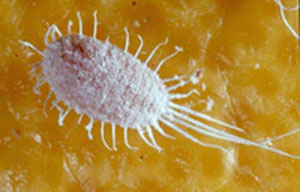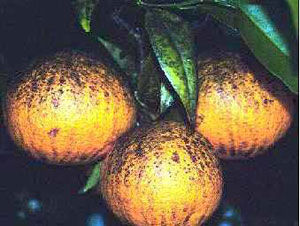
Long tailed mealy bug
Date: 2022 Author: Jianhua Mo
Description

- Adults are 3–4 mm long with mealy wax cover and long tail filaments (as long as or longer than the body). When squashed, the body fluids will be pale yellow.
- The female produces around 200 live young (which she deposits under her body) over a 2–3 week period.
- During summer, the life cycle is completed in around 6 weeks (about 12 weeks in winter).
- There are 3 to 4 generations per year in NSW, VIC and SA.
Damage

- The honeydew produced by mealybugs encourages sooty mould growth, which downgrades fruit quality, and in severe cases, lowers general tree health. Mealybugs are often found in sheltered sites.
Monitoring
- Fortnightly monitoring is critically important throughout November–December.
- Check 5 fruit per tree from 10 randomly selected trees throughout the block.
- Examine under the fruit calyx and, in autumn, check the navels of navel oranges.
Natural predators
- Parasitic wasps
- Lacewings
- Ladybirds
Control measures
- In navel oranges and grapefruit, action should be taken when 10% or more fruit are infested with mealybugs. Action level is 20% for all other varieties. In late November and early December, control is required if the action level is reached before calyx closure.
- Chemical control measures include petroleum spray oils (PSOs) (or PSO and a compatible pesticide) and soap sprays.
ALWAYS READ THE LABEL
Users of agricultural (or veterinary) chemical products must always read the label and any Permit before using the product, and strictly comply with the directions on the label and the conditions of any Permit. Users are not absolved from compliance with the directions on the label or the conditions of the Permit by reason of any statement made or not made in this publication.
WARNING
Pesticide residues may occur in animals treated with pesticides, or fed any crop product, including crop waste, that has been sprayed with pesticides.
It is the responsibility of the person applying a pesticide to do all things necessary to avoid spray drift onto adjoining land or waterways.

